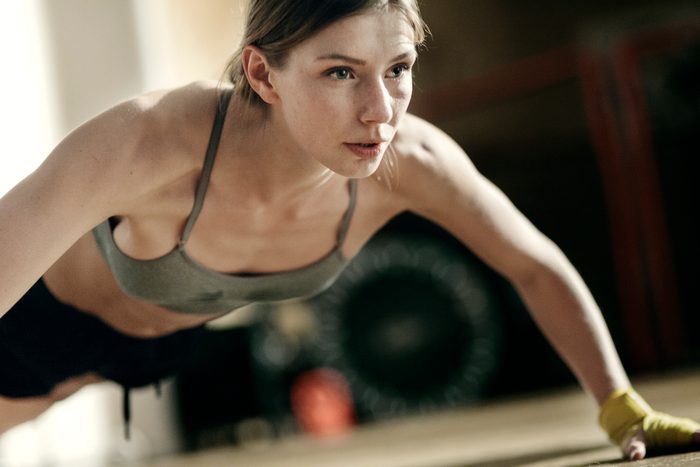Here’s Why You Get Headaches from Exercise—with 3 Doctors’ Tips for Relief
Updated: Jul. 25, 2023

Exercise is often listed as a migraine preventative—but when this writer suffered severe headaches from cardio, doctors nailed a fix.
Migraine Headaches from Exercise
Alcohol, late nights, sun bathing, and roller coasters are just a few of the vices I’ve cut out of my life permanently. I suppose it would sound good if I were to chalk this up to wisdom and maturity, but I have to confess: these changes were due to migraine headaches, and I dare say they’ve turned me into a slightly (very?) dull version of my younger self.
It was when migraines threatened to snatch away my exercising routine that I’d finally had enough.
I’ve suffered migraines for as long as I can remember. I’ve tried every remedy, from massages to incredibly strong prescription meds (I’ve found Imitrex has been a lifesaver).
Neurologists have long warned migraine sufferers to avoid standard triggers such as cocktails, flashing lights, and even stress. (So I could just avoid the stress in my life? Why didn’t I think of that?!) Plus, for me, exercise had never popped up whenever I researched lists of potential migraine triggers. In fact, exercise is often listed as a migraine preventative. So, when I started getting migraines after exercise, I just attributed them to my hormones or the weather.
Exhausted From Living Through Stressful Events? A Resilience Expert’s 6 Tips to Stay Encouraged
My Exercise Migraines Became Regular
But my exercise migraines grew very consistent: every time I took a spin class, I could expect a migraine to start within a half hour of cool-down. The tougher and longer the class, the worse the headache. If I took a spin class focusing on intervals, I might as well take the rest of the day off to stay in bed. I have kids and a career. That just wouldn’t work.
After a few months of tracking these seemingly exercise-induced migraines I spoke with my neurologist, who agreed this was a pattern. Apparently, exercise is a big trigger for migraine sufferers. In fact, as Mia Minen, MD, the chief of headache research at NYU Langone Health tells The Healthy @Reader’s Digest, there have been several small studies showing that some migraine sufferers—ranging from nine percent to 57 percent, depending on which study you reference—do get migraines after an intense run or exercise. One 2013 study in the Journal of Headache and Pain reported that 38 percent of people who already get migraines experience exercise-triggered migraines.
Why Does Exercise Cause Migraine Headaches?
The causes of exercise-induced migraines are muddled. One well-known 2006 study published by the American College of Sports Medicine suggested maneuvers that boost intracranial pressure (that’s excessive pressure inside your skull—think from activities like weight lifting, wrestling, and running) also increase the cerebral arterial pressure. This, in turn, dilates venous sinuses, which causes a migraine.
On the other hand, some neurologists point to dehydration, low blood sugar levels or overheating. No one seems quite sure why exercise is so beneficial for some severe headache patients, while so terribly painful for others.
10 Most Hydrating Foods to Eat (Without Drinking Water)
How to Stop Migraines from Exercise
So what can I—and other exercise-induced migraine sufferers—do about this? Doctors have several suggestions.
My neurologist suggested I could pop an Advil or even an Imitrex 30 minutes prior to exercising. While I’m sure this would work well, I didn’t like the idea of taking so much medication. After all, I exercise six days a week.
Sean Ormond, who is dual board-certified in anesthesiology and interventional pain management, suggests slowly increasing the intensity of exercising, starting from low-impact to high-impact exercises. I tried this and found it’s been moderately effective. Prior to taking a spin class, I do a five-minute warm-up, which has reduced the number of migraines I’ve experienced by about 50 percent.
Jessica Ailani, MD, the director of Medstar Headache Center in Washington, D.C., similarly suggests slowly increasing your heart rate before and after your workout, with a gentle and thorough 10-minute warm-up and 10-minute cool-down. Also, Dr. Ailani says, high-intensity interval training (HIIT training) can be a migraine trigger, so finding other ways to exercise that allows your heart to increase and decrease slower could help.
I tried… but sometimes, I crave a good HIIT workout.
I turned to a relatively new shot, called Emgality (I have no affiliation with the company). I found it quite painful, so here’s a tip I recommend: ice your bottom for an hour before taking the monthly shot). However, it reduced my exercise-induced migraines by 95 percent. Well, that, plus a slow warm-up, slow cool-down, and a shot of pickle juice to quickly restore my electrolytes.
Altogether, the combo’s been a game-changer.
Get The Healthy @Reader’s Digest newsletter for healthy sleep insights delivered on the reg. Follow us on Facebook and Instagram, and keep reading:
- Here’s How Long the Best Nap Lasts, a Neuroscientist Says
- “It’s OK to Slow Down”: The Story Behind TikTok’s Plant-Growing Guru, @Creative_Explained
- Over 40? 4 Gentle Mobility Exercises a Trainer Says You Should Be Doing
- The 10 Best Health Books of 2022: Therapists and Readers Rate the Bestselling Wellness Books So Far This Year
- The 13 Best Walking Shoes, from Podiatrists

















